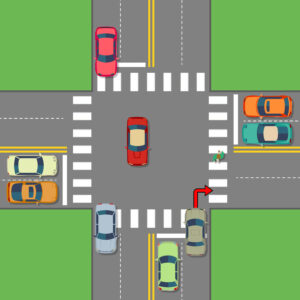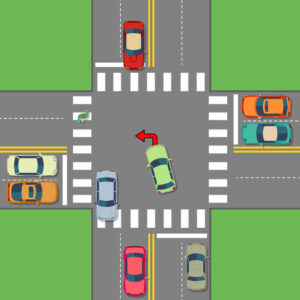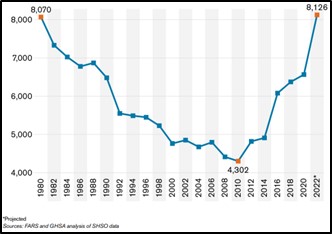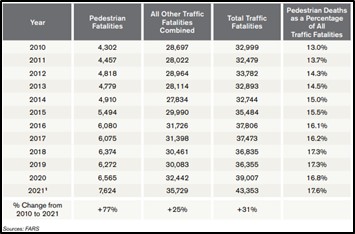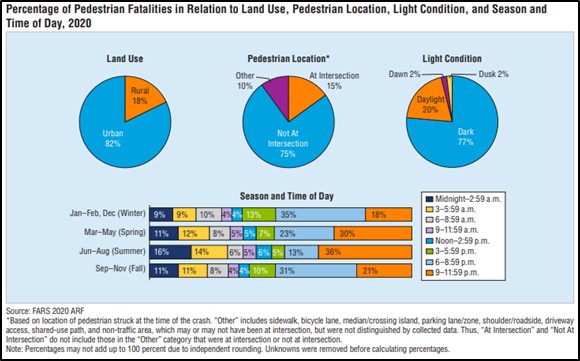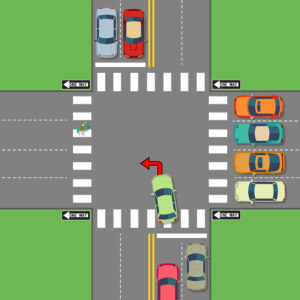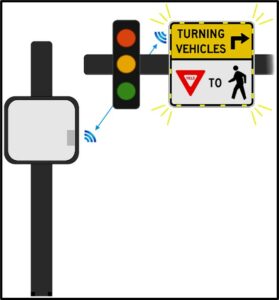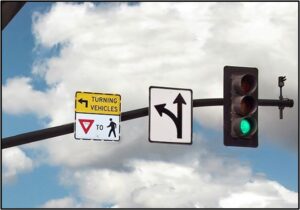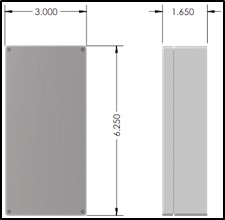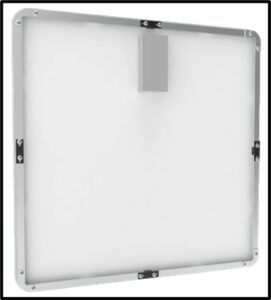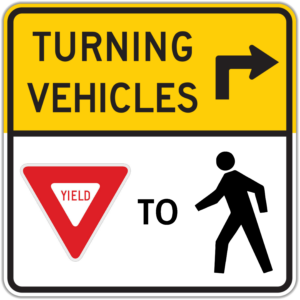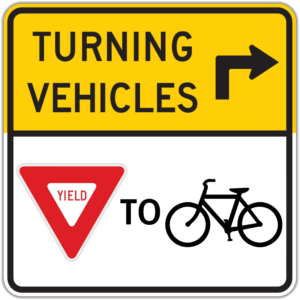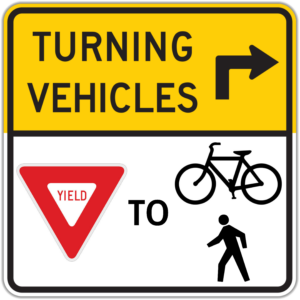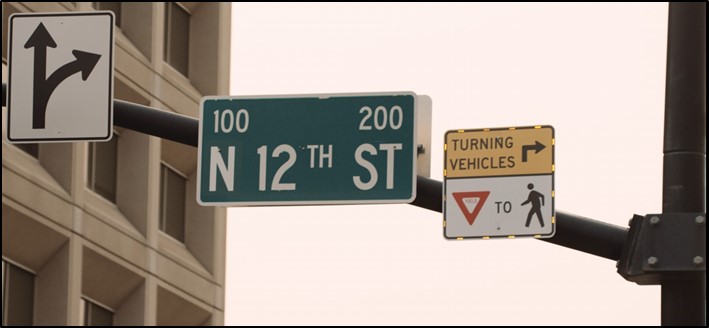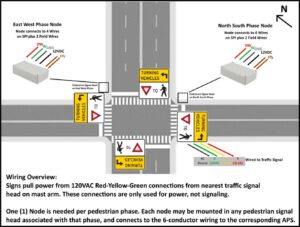TLPI® (Turn Lane Pedestrian Indicator): Protecting Pedestrians by Warning Drivers
Authored By: Travis Goldsby and Katie Behrens
Co-Authored By: Tony Brennan and Josh Meir
Introduction and Situational Purpose:
It is widely acknowledged that optimal pedestrian road-crossing occurs at designated crosswalks when the pedestrian signal displays a walk indication. Generally, adherence to this practice ensures successful and uneventful road crossings. Nevertheless, instances arise wherein adherence to these fundamental guidelines results in conflicts between pedestrians and drivers.

- Scenario 1
Scenario 1 a pedestrian is preparing to cross the street at the crosswalk of a busy intersection. The pedestrian then pushes a button to place a call at the crosswalk and begins to cross while the pedestrian signal head indicates the walk interval. Simultaneously, a driver who is preparing to make a legal right turn on a red light begins to turn into the corresponding intersection said pedestrian is actively using. The driver’s focus is primarily directed toward the oncoming traffic and the traffic signals without necessarily paying attention to the crosswalk they are preparing to drive through. Once the intersection is clear of cars, the driver begins to turn. While turning, they do not realize the pedestrian signal head has changed to walk and there is now a pedestrian who has left the curb and is now in the intersection at the same time, resulting in a collision between the vehicle and the pedestrian.

- Scenario 2
Alternatively, scenario 2 consists of a driver getting ready to make a legal left-hand turn across opposing traffic at an intersection without a dedicated left-turn arrow. The road is a two-lane road with heavy traffic flow traveling in opposite directions and no dedicated turn lane, only the green light allowing for legal turns in traffic gaps. As the traffic light turns green, the driver cautiously advances into the intersection, scanning for an opportunity to navigate through the steady stream of approaching vehicles. Spotting a gap in traffic, the driver proceeds to make the left turn. Unbeknownst to the driver, before initiating the turn, a pedestrian had legally begun to cross during the designated walk interval indicated on the pedestrian signal. The driver’s focus on oncoming traffic led to oversight of the pedestrian in the crosswalk, resulting in a collision between the vehicle and the pedestrian.
These two scenarios exemplify the alarming ease with which collisions between drivers and pedestrians can occur, even when the pedestrian is diligently using a crosswalk. The repercussions of such incidents are devastating for all parties involved, underscoring the critical importance of preventive measures.
Problem Statement:
Pedestrians who are in the act of legally crossing at a crosswalk of a signalized intersection are vulnerable to vehicles making legal turns because drivers are often paying attention to vehicles and traffic lights rather than the pedestrian signal head indications and corresponding pedestrians.
Objective:
At PedSafety we strongly believe that everyone deserves to arrive home safely, and as an advocate for and leader in pedestrian safety, we are actively driving initiatives to transform that commitment into reality.
Throughout this document, the current state of pedestrian safety and the influencing factors hindering pedestrians’ ability to safely cross the street at signalized intersections will be meticulously outlined. The efficacy of PedSafety’s Turn Lane Pedestrians Indicator (TLPI®) in addressing these challenges will be explained, along with a comprehensive exploration of additional intersection features that, when implemented in conjunction with TLPI®, contribute significantly to enhancing pedestrian safety.
Background and Research:
Frequent conflicts and collisions between turning vehicles and pedestrians represent recurring issues at signalized intersections. Pedestrians are expected to always remain vigilant for oncoming drivers while crossing, concurrently drivers are expected to anticipate pedestrians in the crosswalk. This mindset and the way our facilities are structured have contributed to a notable surge in pedestrian fatalities in recent years.
The National Highways Traffic Safety Administration (NHTSA) has compiled fatality data between the Fatality Analysis Reporting System (FARS) and State Highway Safety Offices (SHSO). FARS has an estimated total number of 2022 pedestrian fatalities listed at 8,126, which could be the highest recorded pedestrian deaths since 1980.

- The Fluctuation of Pedestrian Deaths Over the Years
Furthermore, according to the Governors Highway Safety Association (GHSA) Pedestrian Traffic Fatalities by State 2022 Preliminary Data report1 (the most recent year of collected data), from 2010-2021 “pedestrian deaths have gone up a shocking 77%, compared to a 25% increase in all other traffic fatalities”. The report projects a disconcerting 7,508 pedestrian fatalities for the year 2022. While this figure may be lower than estimates from sources such as FARS and SHSO, it remains an alarming statistic. It is crucial to note that these statistics exclusively account for traffic-related fatalities, omitting instances of near misses or those involving minor injuries.

- Cause of Pedestrian Fatalities Over the Years
Moreover, the U.S. Department of Transportation National Highway Traffic Safety Administration’s latest data from 2020 reveals that pedestrian fatalities constituted 17% of all traffic-related deaths. Notably, their findings show that 82% of pedestrian fatalities occurred within urban settings, with 15% transpiring at intersections. Time of Day and light additionally conditions played a significant role in increasing pedestrian fatalities with 77% of fatalities occurring in the dark as compared to 20% occurring in daylight, 2% at dusk, and 2% at dawn Examining these statistics holistically, it becomes evident that a comprehensive solution is imperative to curb the rising number of fatalities at urban intersections, particularly during periods of reduced lighting conditions.

- Fatality Comparison in Relation to External Factors
Several instances between vehicles and pedestrians occur at the intersection with mitigating factors which has been shown to lead to collisions between pedestrians and vehicles. The most prominently highlighted are instances of:
-
- Pedestrian and vehicle accidents occurring during a legal right-hand turn on a red light
- Pedestrian and vehicle accidents occurring during a right-hand turn on a green light
- Pedestrian and vehicle accidents occurring during a legal left-hand turn on a green light without a protected turn arrow
- Pedestrian and vehicle accidents occurring during a legal left-hand turn on a flashing yellow arrow
- Pedestrian and vehicle accidents occurring during a legal left-hand onto a one-way turn on a red light
- Pedestrian and vehicle accidents due to lack of visibility in low light and nighttime conditions
- Pedestrian and vehicle accidents due to lack of visibility in extreme weather conditions
-

- 1 and 2

- 3 and 4

- 5
A 1997 report by Rasanen and Summala highlighted the notion that “drivers primarily focused their attention towards left oncoming vehicles” (Rasanen and Summala, 1997). This trend persists regardless of whether a driver is executing a right-turn-on-red or a right-turn-on-green, with their focus often directed away from the crossing. Typically, drivers search for oncoming traffic or glance at the traffic signal to confirm the green light, neglecting to prioritize the crosswalk and the presence of pedestrians. Unfortunately, the market lacks products designed to redirect the driver’s attention away from other vehicles and signals, guiding it toward the crosswalk and the pedestrian.
In the case of left turns, visibility challenges arise as other vehicles may obstruct the view of pedestrians at an approach. An A-pillar which is referred to as the section of the vehicle between the front windshield and driver window, creates a blind spot, hindering a driver’s ability to track pedestrians crossing in the same direction as their moving vehicle. This becomes a potential threat to pedestrians attempting to cross, as the blind spot reduces the time available for a driver to react and come to a stop upon identifying a pedestrian in the act of crossing.

- Driver’s View of Pedestrians Crossing
Regardless of the type of turn being made, pedestrians consistently face a disadvantage at intersections. Drivers remain preoccupied with other vehicles or traffic signals, often neglecting the essential attention required for the crosswalk and the safety of pedestrians.
Proposed Solution – Increasing Pedestrian Safety Through the Turn Lane Pedestrian Indicator:
In the pursuit of safer roads and reduced pedestrian accidents, TLPI® (Turn Lane Pedestrian Indicator) emerges as a revolutionary safety feature designed to shift the focus onto vehicle drivers. This innovative system utilizes advanced LED technology that adapts to ambient light conditions, actively alerting drivers to the presence of pedestrians and cyclists either in or about to enter the crosswalk after a call has been placed.
To effectively decrease accidents between vehicles and pedestrians in the crosswalk, a proactive approach is necessary. Drivers require innovative warnings to alert them to the presence of active or soon-to-be-active crosswalks. Often preoccupied with oncoming traffic and traffic signals, drivers need a visual cue to redirect their attention and reduce conflicts with pedestrians at intersections.
The TLPI® achieves this through a lighted R10-15 regulatory warning sign or another designated warning sign for drivers, utilizing an LED ring, backlit features, or a combination of both, complemented by retro-reflective sheeting. Activation occurs after a pedestrian initiates the signal by using a pedestrian push button (PPB) or an Accessible Pedestrian Signal (APS). This targeted activation enhances the effectiveness of the warning system, ensuring it captures drivers’ attention precisely when needed.
How TLPI® Works:
The Turn Lane Pedestrian Indicator (TLPI®) comprises three integral components: the Node, the Sign Driver, and the sign itself, each playing a critical role.
Firstly, the Node, installed either within or on the pedestrian signal head, operates by sending a wireless signal at 900 MHz upon activation of a specific pedestrian phase via a button press. This signal is then received by the Sign Driver, located on the back of the sign, which subsequently controls the activation and deactivation of the sign.

- Diagram Showing TLPI®’s Wireless Communication
The Node relies on a Signal Power Interface (SPI) to convert the standard 120VAC (or 48VDC for 48V intersections) power source into 12VAC, obtaining information regarding the pedestrian phase status. This data is transmitted wirelessly to the Sign Driver, dictating when the sign should commence and cease flashing.
The Sign Driver, installed on the back of the backlit or LED ring regulatory sign, is powered by the traffic signal’s 120VAC (or 48VDC for 48V intersections). The Sign Driver regulates the flashing rate and duration of the sign’s illumination through a 3C cable connection, as it receives signals sent from the Node. This ensures synchronization with pedestrian phases, allowing for optimal effectiveness.

- TLPI® Installed at an Intersection
Programming flexibility enables the sign to flash at various times, as soon as a pedestrian has placed a call, or at the beginning of the walk interval. Additionally, the sign can be programmed to turn off at the end of the Walk interval just before the Countdown interval begins or it can remain lit during the Countdown interval. When utilized without a Leading Pedestrian Interval (LPI), immediate flashing is recommended to capture drivers’ attention effectively.
Conversely, in conjunction with an LPI, initiating flashing at the start of the walk cycle is advisable as LPI allows the pedestrians to have a will have a 3-7 second head start before the traffic light changes. This prevents prolonged flashing periods before the onset of the walk interval, optimizing sign efficacy because the driver is more likely to notice the sign come out of a solid no flash into a flashing mode. Ultimately, strategic coordination between the TLPI® components and pedestrian phases aims to maximize pedestrian safety without compromising traffic flow efficiency.
Benefits and Advantages:
TLPI® offers valuable advantages for pedestrians in various scenarios. Particularly during the most dangerous time of day for pedestrians, nighttime. TLPI® proves to be vital and its implementation during these hours effectively directs attention to the presence of pedestrians at intersections. The system also excels in low-visibility conditions caused by adverse weather.
Installers benefit significantly from TLPI® as well. The wireless transmission of signals from the Node to the Sign Driver eliminates the need to navigate clogged or crushed conduit conduits. Furthermore, the sign receives power from the nearest traffic signal, negating the necessity to access junction boxes or run wire through the entire mast arm.

- Node Dimensions
Flexibility is a key feature of the Sign Driver, as it seamlessly integrates with lighted signs from any manufacturer. This enables agencies to continue working with their preferred manufacturers, utilizing existing mounts without the need for specialized hardware. The result is a streamlined and adaptable solution for enhanced pedestrian safety and installer convenience.

- LED Sign Backlight with Sign Driver
On top of flexibility with the sign driver, TPLI® can be applied to a multitude of different intersections and is used to enhance either pedestrian or cyclist safety by focusing the attention of drivers on those crossing. While an R10-15 sign is the most common application, TPLI® can accommodate many different scenarios with signs showing to yield to pedestrians, cyclists, or a combination of the two.

- Right Turn Yield to Pedestrians Sign

- Right Turn Yield to Cyclists Sign

- Right Turn Yield to Cyclists and Pedestrians Sign
TLPI®, LPI, and Additional Safeguards:
TLPI® can be effective on its own yet its efficacy can be further enhanced when paired with other solutions. One such approach involves integrating a leading pedestrian interval (LPI), which starts the walk interval 3-7 seconds before vehicles are given a green light, can be paired with it. This proactive timing allows pedestrians to establish their presence in the crosswalk before vehicles have priority to turn right or left. The synchronization of the TLPI® with LPI not only increases the likelihood of a driver turning from a complete stop to recognize an actively crossing pedestrian but also amplifies the overall impact on intersection safety.
The Federal Highway Administration’s research indicates that LPIs alone reduce pedestrian-vehicle crashes by 13% at intersections. When harmoniously paired with TLPI®, we anticipate an even more significant reduction in such incidents.
While TLPI® and LPIs prove to be formidable tools for pedestrian safety, it’s crucial to acknowledge that the effectiveness of an LPI for visually impaired pedestrians hinges on its integration with an Accessible Pedestrian Signal (APS). The 11th edition of the Manual on Uniform Traffic Control Devices (MUTCD) states, “if a leading pedestrian interval is used without accessible features, pedestrians with vision disabilities might begin crossing at the onset of the vehicular movement when vehicle operators are not expecting them to begin crossing.” This would provide the opposite of the intended result of the LPI.
Beyond the use of TLPI® and LPI cohesively, there exist additional layers of there are other safeguards that can significantly enhance safety outcomes. Research substantiates the effectiveness of supplementary lighting in mitigating both vehicle and pedestrian collisions. Diverse lighting options, ranging from overhead illumination to in-roadway lighting, offer tailored solutions based on the specific environmental context. While in-roadway lighting might not universally address every setting, its deployment in suitable environments can be instrumental.
Moreover, the incorporation of raised crosswalks represents another safeguard in select scenarios. When coupled with TLPI®, this combination becomes a formidable deterrent against collisions. The TLPI® flashing sign not only captures the attention of drivers, but the presence of raised crosswalks compels them to navigate more cautiously, contributing to collision prevention. Notably, raised crosswalks elevate the visibility of pedestrians in the driver’s line of sight.
However, the applicability of raised crosswalks is context-dependent. They are ideally suited for intersections on 2 or 3-lane roads with speed limits of 30 mph or lower, they may not be universally viable and should be judiciously avoided on designated truck routes. This nuanced approach ensures that the integration of safeguards aligns seamlessly with the specific characteristics of the roadway, maximizing their efficacy in promoting safety for both pedestrians and drivers.
Future TLPI® Integrations:
As the influx of connected vehicles enters our roadways, TLPI® stands poised to provide additional opportunities to alert drivers. In forthcoming TLPI® installations, the integration of connected vehicle capabilities will enable the seamless transmission of real-time information directly to cars. This innovative feature will serve as an advanced warning system, by signaling drivers to the presence of individuals either within or on the verge of entering a crosswalk, directly corresponding to the upcoming turn lane.
Anticipating the evolution of TLPI®, there’s the potential for the incorporation of specialized lighting. Positioned discreetly at the bottom of a pedestrian signal head, this lighting component could activate to illuminate the onset of pedestrian crossings, providing additional visibility for those on foot. However, it is imperative to undertake meticulous research and testing to establish best practices, ensuring that this supplementary lighting augments safety without compromising a driver’s line of sight. This forward-thinking approach positions TLPI® as an adaptive and cutting-edge solution, actively evolving to meet the demands of our dynamic transportation landscape.
TLPI® Installations:
Boise, Idaho, features the two original locations of TLPI® installations, each strategically chosen to enhance pedestrian safety. The first site, at the intersection of Idaho St. and 12th St., consists of a three-lane, one-way road intersecting with a two-lane, two-way street. Recognizing the pedestrian traffic from nearby restaurants and downtown, TLPI® with an R10-15 sign was installed to alert drivers turning onto 12th St. from Idaho St. about potential pedestrian presence. With ongoing construction on the south side of Idaho St., left-turning vehicles face increased difficulty in spotting pedestrians during crossing, making TLPI® pivotal in safeguarding pedestrians amidst the construction.

- TLPI® Intersection Installation at 12th St
The second location, at 11th St. and State St., is a very heavily trafficked pedestrian area. Situated adjacent to the Downtown Boise YMCA on the east corner. The North corner houses a Subway restaurant, the South corner is overflow parking for the YMCA, and the West corner is a Taekwondo training center, all of which accumulates heavy foot traffic. Between the months of January and July of 2023, the intersection became the scene of four pedestrian-vehicle accidents, tragically resulting in one fatality. Responding to this concerning trend, the Ada County Highway District (ACHD) Commissioners, governing all roads in Ada County (not owned by the Idaho Department of Transportation), decided to deploy TLPI® after witnessing its effectiveness in other Boise intersections.
In conjunction with TLPI®, ACHD implemented significant changes at the 11th St. and State St. intersection. Transitioning from a recall to a fully actuated intersection, they encouraged pedestrians to utilize the crosswalk buttons to initiate signal changes. Additionally, they introduced Leading Pedestrian Intervals (LPI) on all four crossings, capitalizing on existing Accessible Pedestrian Signals (APS) for visually impaired pedestrians. The decision to synchronize the R10-15 sign’s flashing with the Walk interval, instead of immediate activation upon button press, was strategic. This adjustment aimed to align the sign’s flashing with the onset of the green light, preventing driver desensitization while ensuring pedestrian safety.
Furthermore, ACHD ensured continuous flashing of the sign throughout both the Walk and Flashing Don’t Walk intervals, guaranteeing visibility when pedestrians might be in the crosswalk. As a result of these measures, in the eight months following installation, pedestrian-vehicle collisions at the intersection plummeted to zero, underscoring the effectiveness of TLPI® in enhancing pedestrian safety.

- Drawing Showing how TLPI® can be Used at a 4-Way Intersection
In the 8 months since this intersection was installed and this report was written the number of collisions between pedestrians and vehicles has decreased to 0.
Conclusion:
In conclusion, the alarming frequency of collisions between pedestrians and vehicles at signalized intersections, with pedestrian fatalities at their highest rate since the 1980s, underscores the urgent need for effective preventive measures. Despite pedestrians diligently adhering to designated crosswalks and signal indications, conflicts with turning vehicles persist, leading to devastating consequences. The rising trend in pedestrian fatalities, as evidenced by data from sources like the National Highway Traffic Safety Administration (NHTSA) and the Governors Highway Safety Association (GHSA), demands immediate action to address the root causes of these incidents.
The proposed solution, Turn Lane Pedestrian Indicator (TLPI®), offers a revolutionary approach to enhance pedestrian safety by shifting the focus onto vehicle drivers. TLPI® employs advanced LED technology to alert drivers to the presence of pedestrians in or about to enter the crosswalk, particularly during critical times such as nighttime or adverse weather conditions. By synchronizing with pedestrian phases and incorporating leading pedestrian intervals (LPIs) where applicable, TLPI® significantly reduces the risk of collisions between vehicles and pedestrians.
Moreover, TLPI® installations in locations like Boise, Idaho, have yielded promising results, with significant reductions in pedestrian-vehicle collisions observed within a relatively short period. The success of TLPI® highlights its effectiveness as a proactive safety measure, complementing existing traffic control systems and infrastructure.
Looking ahead, the integration of TLPI® with emerging technologies such as connected vehicles holds promise for further enhancing pedestrian safety. Additionally, ongoing research and innovations in supplementary lighting and intersection design will continue to refine and optimize pedestrian safety measures.
In essence, the implementation of TLPI® represents a crucial step towards creating safer road environments for pedestrians and drivers alike. By prioritizing pedestrian safety and investing in innovative solutions like TLPI®, we can strive towards the shared goal of ensuring that everyone arrives home safely.
Who Are We:
PedSafety is a Boise, Idaho-based company specializing in the design and manufacturing of pedestrian accessibility solutions. As an ISO 9001-certified American manufacturer with full capabilities in design, engineering, machining, powder coating, automated PCBA manufacturing, graphics/screen printing, and professional assembly. While our primary focus is on pedestrian push buttons and we strive to provide all pedestrians with the means to cross streets safely, we extend our products to accommodate bicyclists and metro users, promoting inclusive access to public transportation in our community.
References:
-
- Governors Highway Safety Association https://www.ghsa.org/sites/default/files/2023-06/GHSA%20%20Pedestrian%20Traffic%20Fatalities%20by%20State%2C%202022%20Preliminary%20Data20%28January-December%29.pdf
- Kim, Wonho, Gur-joong Kim, Dongmin Lee International Journal of Urban Sciences 20:2, 226-240, DOI: 10.1080/12265934.2016.1183511
- New York City Department of Transportation, Vision Zero https://www.nyc.gov/html/dot/downloads/pdf/left-turn-pedestrian-and-bicycle-crash-study.pdf
- Räsänen, Mikko, Heikki Summala Traffic Research Unit, Department of Psychology https://www.sciencedirect.com/science/article/abs/pii/S0001457598000074)
- Retting, Richard A. (1999), Transportation Quarterly, Spring 1999 https://www.iihs.org/topics/bibliography/ref/1165
- U.S. Department of Transportation, Federal Highway Administration https://highways.dot.gov/sites/fhwa.dot.gov/files/Leading%20Pedestrian%20Interval_508.pdf


